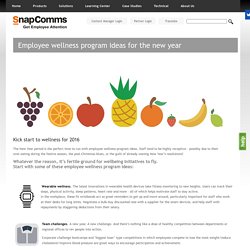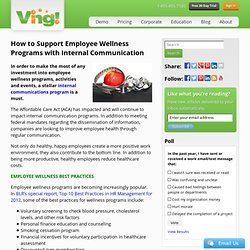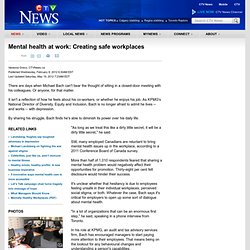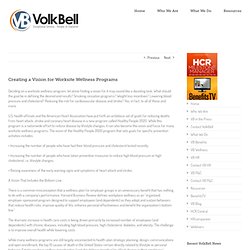

Employee Wellness Program Ideas. Wearable wellness.

The latest innovations in wearable health devices take fitness monitoring to new heights. Users can track their steps, physical activity, sleep patterns, heart rate and more – all of which helps motivate staff to stay active. In the workplace, these fit wristbands act as great reminders to get up and move around, particularly important for staff who work at their desks for long stints. Negotiate a bulk-buy discounted rate with a supplier for the smart devices, and help staff with repayments by staggering deductions from their salary. Team challenges. Corporate challenge bootcamps and ‘biggest loser’ type competitions in which employees compete to lose the most weight/reduce cholesterol/improve blood pressure are great ways to encourage participation and achievement.
Rethink the office layout. For example, reposition frequently-visited sites – such as the water cooler, stationery cupboard, and printer/scanner to a higher floor, or further down the hall.
Make your wellness programs a success. By Joan Farrell, JD, BLR Legal Editor For a Limited Time receive a FREE Safety Special Report on the "50 Tips For More-Effective Safety Training.

" Receive 75 pages of useful safety information broken down into three training sections. Download Now. How to Support Employee Wellness Programs with Internal Communication. In order to make the most of any investment into employee wellness programs, activities and events, a stellar internal communications program is a must.

The Affordable Care Act (ACA) has impacted and will continue to impact internal communication programs. In addition to meeting federal mandates regarding the dissemination of information, companies are looking to improve employee health through regular communication. Not only do healthy, happy employees create a more positive work environment, they also contribute to the bottom line. In addition to being more productive, healthy employees reduce healthcare costs. Employee wellness programs are becoming increasingly popular. This is a full list of best practices. Top 3 takeaways from HBLC. Mental health at work: Creating safe workplaces. Vanessa Greco, CTVNews.ca Published Wednesday, February 8, 2012 6:30AM EST Last Updated Saturday, May 19, 2012 7:23AM EDT There are days when Michael Bach can't bear the thought of sitting in a closed-door meeting with his colleagues.

Or anyone, for that matter. It isn't a reflection of how he feels about his co-workers, or whether he enjoys his job. As KPMG's National Director of Diversity, Equity and Inclusion, Bach is no longer afraid to admit he lives -- and works -- with depression. By sharing his struggle, Bach finds he's able to diminish its power over his daily life. "As long as we treat this like a dirty little secret, it will be a dirty little secret," he said. Still, many employed Canadians are reluctant to bring mental health issues up in the workplace, according to a 2011 Conference Board of Canada survey.
More than half of 1,010 respondents feared that sharing a mental health problem would negatively affect their opportunities for promotion. Tried and True Wellness Communication Strategies. We are always looking for the next best practice approach to help our organizations accomplish their wellness goals and corral health care costs; the silver bullet for good health and cost management.

What can we do to help employees make a commitment to health improvement and actually stick with it! But, like Dorothy in the Wizard of Oz, maybe you don’t have to look beyond your own backyard. The tried and true principles of effective communication apply to wellness programs, as they do to all other types of communication. Here are some basic communication strategies to consider for your 2012 wellness communication plan: Brand your wellness program: It’s tough to get anyone’s attention in our media-saturated culture. Involve employees: Get employees involved in the communication process. The Twelve Attributes of a Truly Great Place to Work - Tony Schwartz. By Tony Schwartz | 8:42 AM September 19, 2011 More than 100 studies have now found that the most engaged employees — those who report they’re fully invested in their jobs and committed to their employers — are significantly more productive, drive higher customer satisfaction and outperform those who are less engaged.

But only 20 per cent of employees around the world report that they’re fully engaged at work. It’s a disconnect that serves no one well. So what’s the solution? Where is the win-win for employers and employees? The answer is that great employers must shift the focus from trying to get more out of people, to investing more in them by addressing their four core needs — physical, emotional, mental and spiritual — so they’re freed, fueled and inspired to bring the best of themselves to work every day. It’s common sense. Our first need is enough money to live decently, but even at that, we cannot live by bread alone. Creating a Vision for Worksite Wellness Programs.
Deciding on a worksite wellness program, let alone finding a vision for it may sound like a daunting task.

What should the goal be in defining the desired end results? Smoking cessation programs? Weight loss incentives? Lowering blood pressure and cholesterol? Reducing the risk for cardiovascular disease and stroke? U.S. health officials and the American Heart Association have put forth an ambitious set of goals for reducing deaths from heart attack, stroke and coronary heart disease in a new program called Healthy People 2020. . • Increasing the number of people who have had their blood pressure and cholesterol tested recently; • Increasing the number of people who have taken preventive measures to reduce high blood pressure or high cholesterol, i.e. lifestyle changes; • Raising awareness of the early warning signs and symptoms of heart attack and stroke.